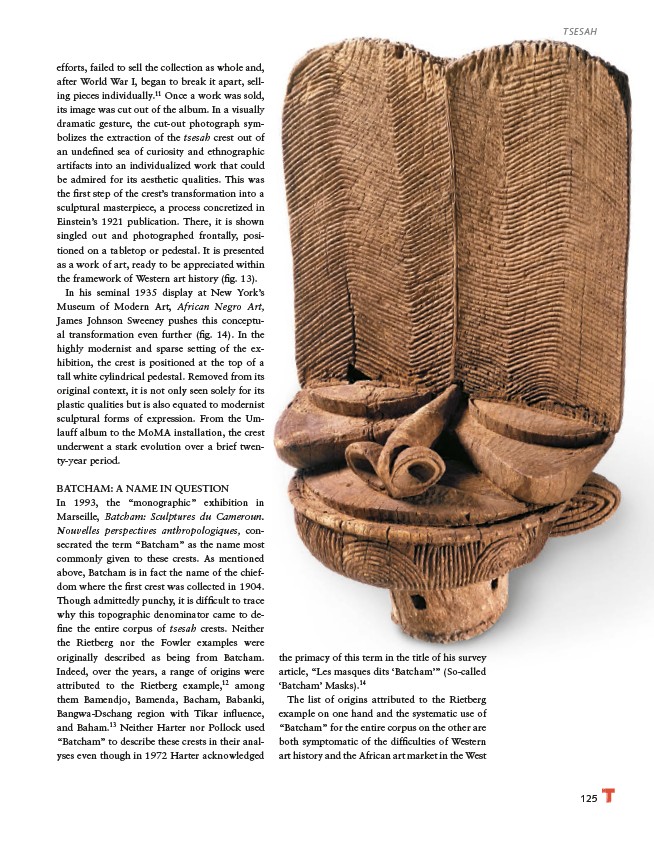
TSESAH
125
efforts, failed to sell the collection as whole and,
after World War I, began to break it apart, selling
pieces individually.11 Once a work was sold,
its image was cut out of the album. In a visually
dramatic gesture, the cut-out photograph symbolizes
the extraction of the tsesah crest out of
an undefined sea of curiosity and ethnographic
artifacts into an individualized work that could
be admired for its aesthetic qualities. This was
the first step of the crest’s transformation into a
sculptural masterpiece, a process concretized in
Einstein’s 1921 publication. There, it is shown
singled out and photographed frontally, positioned
on a tabletop or pedestal. It is presented
as a work of art, ready to be appreciated within
the framework of Western art history (fig. 13).
In his seminal 1935 display at New York’s
Museum of Modern Art, African Negro Art,
James Johnson Sweeney pushes this conceptual
transformation even further (fig. 14). In the
highly modernist and sparse setting of the exhibition,
the crest is positioned at the top of a
tall white cylindrical pedestal. Removed from its
original context, it is not only seen solely for its
plastic qualities but is also equated to modernist
sculptural forms of expression. From the Umlauff
album to the MoMA installation, the crest
underwent a stark evolution over a brief twenty
year period.
BATCHAM: A NAME IN QUESTION
In 1993, the “monographic” exhibition in
Marseille, Batcham: Sculptures du Cameroun.
Nouvelles perspectives anthropologiques, consecrated
the term “Batcham” as the name most
commonly given to these crests. As mentioned
above, Batcham is in fact the name of the chiefdom
where the first crest was collected in 1904.
Though admittedly punchy, it is difficult to trace
why this topographic denominator came to define
the entire corpus of tsesah crests. Neither
the Rietberg nor the Fowler examples were
originally described as being from Batcham.
Indeed, over the years, a range of origins were
attributed to the Rietberg example,12 among
them Bamendjo, Bamenda, Bacham, Babanki,
Bangwa-Dschang region with Tikar influence,
and Baham.13 Neither Harter nor Pollock used
“Batcham” to describe these crests in their analyses
even though in 1972 Harter acknowledged
the primacy of this term in the title of his survey
article, “Les masques dits ‘Batcham’” (So-called
‘Batcham’ Masks).14
The list of origins attributed to the Rietberg
example on one hand and the systematic use of
“Batcham” for the entire corpus on the other are
both symptomatic of the difficulties of Western
art history and the African art market in the West